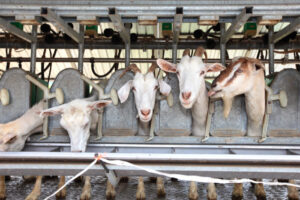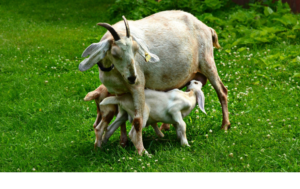Introduction
Dairy goat farming is increasingly gaining popularity particularly in the high potential areas where land for dairy cows is diminishing. Like the dairy cow, dairy goats require good management.
Dairy goat breeds
The recommended breeds are:
• Anglo-nubian
• Toggenburg
• Alpines
• Saanen.
Breeding management
Female goats (does) should be mated at about 12 months of age to kid at 18 months of age. Mating is best done 12 hours after heat is first observed.
Goat fertility reaches maximum at 5 to 6 years of age and the same applies to milk production.
Feeding of lactating goat
Quality feeds should be provided to the lactating goat during the first three months of lactation.
The feeds should also be varied to stimulate high intake and high forage intakes in pregnancy result
in higher feed intakes in early lactation.
The daily concentrate allowance should be increased during the first 4 to 6 weeks post-kidding but not to exceed 0.5 kg. concentrate.
Problems of reproduction
The goat appears to be more susceptible to abortion than other species of domestic livestock.
Most abortions occur in response to stress around 90 to 110 days of gestation.
Such abortions can be reduced by improved nutrition and management or by selection of an animal which has nutritional requirements more in line with that provided by the environment.
Rearing of goat kids
Feed first milk (colostrum) to goat kids for the first 3 days after birth. This stimulates the alimentary canal, provides vitamin A and contains antibodies which confer immunity against diseases.
After 3 or 4 days, feed 0.7 to 0.9 litres of milk or milk replacer daily either on a bottle or from a pan.
Feed this total milk 3 to 5 times a day.
At 3 to 4 weeks of age, provide access to a good starter feed like good quality grass and concentrate.
Discontinue milk feeding at 3 to 4 months. In milk goats it is essential to wean early so that the milk can be available for domestic use. Weaning can be completed at any time after 3 months without using milk substitutes.
Female kids should be given about 1.0 kg of milk daily while male kids should get 1.5 kg. daily.
Non breeding male kids should be castrated soon after birth using rubber rings, or burdizzo.
Housing of the goat
A simple housing built using locally available materials is recommended to save on cost.
Housing for kids varies from place to place. Loose stalls which measure 1.8 m x 1.8 m, and 1.2m
high may house up to 10 kids. Bucks may be housed in stalls measuring 2.4 m x 1.8 m.
Health management
Diseases and parasites cause losses in both quality and quantity of meat and milk and contribute to goat mortality. The major diseases of goats are:
• Contagious Ecthyma (ORF)
• Brucellosis— causes abortion
• Streptothricosis
• Foot rot
• Haemonchus contortus
• Coccidiosis
• Contagious caprine pleuropneumonia (CCPP)
Dairy goats can be perfect for the small homesteader who wants a steady producing dairy animal, but perhaps doesn’t have the space or housing available to raise a cow.
Before choosing a dairy goat breed, there are a few things you need to know about dairy goats in general.
- Dairy goats must be milked twice a day, 12 hours apart
- They must be bred and give birth (usually each year) in order to produce milk
So, before you buy a dairy goat, you must realize that you will have to find a buck each fall and you will have to find a solution to the 1–4 kids being born each spring if you want to keep your girls in milk. Dairy goats also need quality grain or alfalfa, grass hay, minerals, and pasture. Dairy goat nutrition is especially important because for most of their lives, does are either pregnant or lactating. This requires adequate protein and balanced feed. Goat milk, when tasted raw, is much like cow’s milk in flavor. Goat milk gets its “goaty” flavor from being either aged or heated for pasteurization. This flavor has a slight tang similar to that of Greek yogurt or store-bought goat cheese.
Goat milk is also healthier than cow’s milk:
- Goat milk is easier to digest due to its smaller protein and fat molecules
- It contains less lactose than cow’s milk
- It also has about 89% less alpha s1-casein, which is known to cause milk allergies It has:
- 13% more calcium
- 25% more vitamin B6
- 47% more vitamin A
- And 134% more potassium than cow’s milk
Butterfat
Butterfat is what gives goat milk its sweet flavor. It also makes the milk richer, results in more decadent cream and allows you to make more butter per gallon.
Goat milk is naturally homogenized, which means the butterfat is emulsified into the milk and will not rise to the top as easily as in cow’s milk. In order to “harvest” your goat cream to make butter, etc., you will need a milk separator. This is a machine that uses centrifugal force to whip the fat-laden cream away from the skim milk.
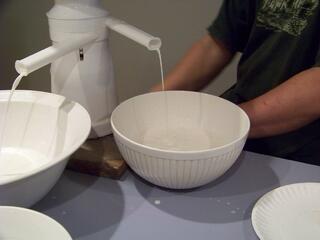
Each breed is known to have an “average” butterfat content (see below). Breeds whose milk contains a higher amount of butterfat tend to give less of it. Knowing this can help you to choose which breed is best for your purposes.
Dairy Goat Breeds
Technically you can milk any goat, but these seven are the best known in the United States and probably the easiest to find.
Saanen
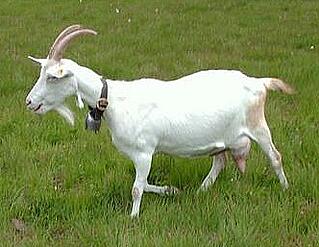
- Weight: Does: 135 lbs+; Bucks: 165 lbs+
- Height at withers: Does: 30″; Bucks: 32″
- Average amount of milk per day: 1 1/2–3 gallons
- Butterfat content: 3%
The Saanen a large dairy goat and the highest in milk production. This hearty breed boasts a calm temperament, and though large they are great with children. They have the traditional upright, forward-facing Alpine ears. The coat is usually white or off-white.
Alpine
- Weight: Does: 130 lbs+; Bucks: 170 lbs+
- Height at withers: Does: 30″; Bucks: 35″
- Average amount of milk per day: 1–2 gallons
- Butterfat content: 3.5%
The Alpine is also a large breed of dairy goat, whose weight is similar to that of the Saanen breed. This breed was developed in the French Alps. We used to raise Alpines and found them to have very gentle dispositions and high production rates throughout the year.
Oberhasli
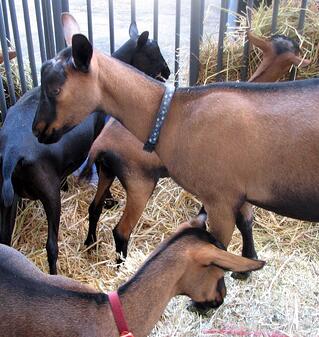
- Weight: Does: 120 lbs+; Bucks: 150 lbs+
- Height at withers: Does: 28″; Bucks: 30″
- Average amount of milk per day: 1/2–1 gallon
- Butterfat content: 3.8%
The Oberhasli is a medium-size goat from Switzerland. The Alpine breed was established from the Oberhasli. It produces less milk than the larger breeds, but the milk it does produce has a higher butterfat content. Not only is the Oberhasli a good dairy goat, but they make great pack animals. They have a gentle temperament and are more willing to please than some other breeds. This goat breed’s unique coloring is called chamoisée—a deep, rich, reddish bay color with black tips, a black dorsal stripe, and black lower legs.
Nubian
- Weight: Does: 135 lbs+; Bucks: 175 lbs+
- Height at withers: Does: 30″; Bucks: 35″
- Average amount of milk per day: 1 gallon
- Butterfat content: 5%
Nubians are my favorite breed and the type of dairy goat we raise on our farm. The first time I saw a Nubian, with their long floppy ears and curved Roman nose, I fell in love. Nubians produce the highest butterfat content of the large dairy breeds. We’ve raised both Alpines and Nubians and I prefer the flavor of Nubian milk, which is sweeter and richer.
Nubians, though large, are an uppity, high-energy breed. They are also extremely loud at times. Both the kids and the adults utter a loud, hollering call when they want something. It often sounds like they’re in pain or dying, but it’s usually something trivial like being separated from their herd mates or wanting a treat.
They can be a bit more willful than other breeds and a bit more destructive. In my opinion, they are harder to train and more cunning.
They are an African breed, and because of their warm-weather background can be bred year-round.
LaMancha
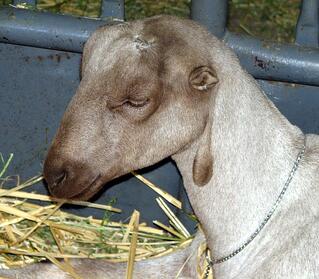
- Weight: Does: 125 lbs+; Bucks: 130 lbs+
- Height at withers: Does: 28″; Bucks: 30″
- Average amount of milk per day: 1 gallon
- Butterfat content: 4.2%
The LaMancha is the only goat breed developed in the United States. It was created by Eula Fay Frey in Oregon in the 1930s. The LaMancha was developed from short-eared Spanish goats crossed with Nubians. The resulting breed has very short ear flaps categorized into two types:
- The gopher ear, in which the ear flap is mostly nonexistent
- The elf ear, in which the tip of the ear is slightly pointed The LaMancha’s milk has the second-highest butterfat content of the large dairy breeds and does can go more than a year without needing to be freshened (bred).
Toggenburg
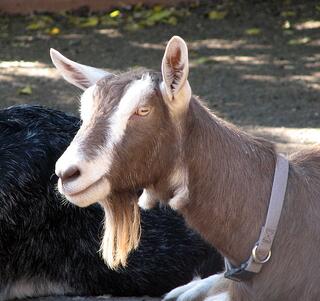
- Weight: Does: 120 lbs+; Bucks: 145 lbs+
- Height at withers: Does: 26″; Bucks: 28″
- Average amount of milk per day: 1 1/2–2 gallons
- Butterfat content: 3.7%
The Toggenburg is the oldest dairy breed. It originated in Switzerland, developed in the Toggenburg Valley at Obertoggenburg. They are a spirited, playful breed. Their coloring is often a grayish brown with cream stripes from the eyes to the nose and cream on the lower legs.
Nigerian Dwarf
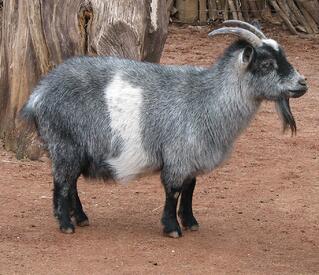
- Weight: Does: 50 lbs; Bucks 70 lbs
- Height at withers: Does: less than 22.5″; Bucks: less than 23.5″
- Average amount of milk per day: 1/2 gallon
- Butterfat content: 6–10%
The Nigerian Dwarf is the smallest goat in the dairy group. Though small, this little goat’s milk produces the highest butterfat content of any other dairy goat. Their milk is also higher in protein. They are a playful breed, easy to care for and wonderful around children. Once you’ve decided on which breed(s) to raise

